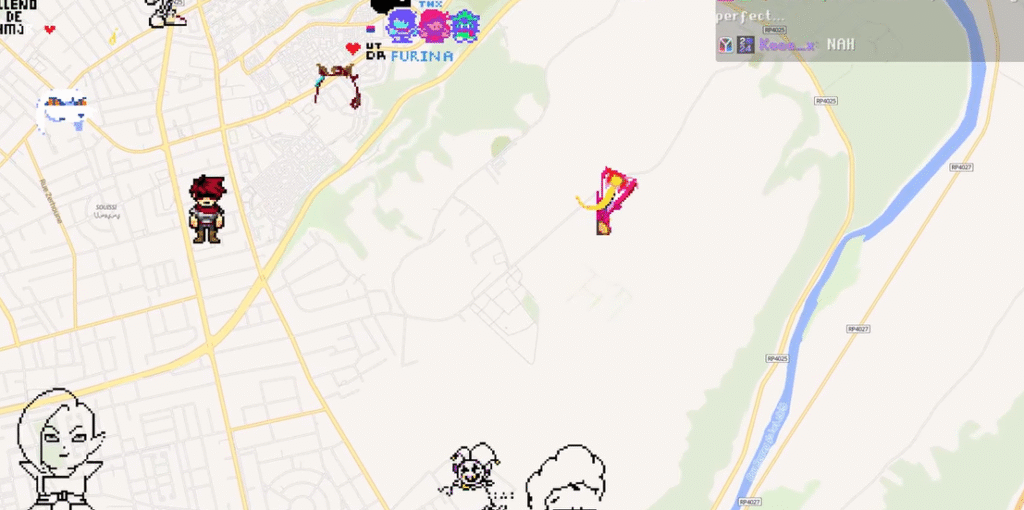One pixel at a time, Wplace invites anyone with an internet connection to participate in a continuous, group act of creation. Each user can place a single pixel every 30 seconds, creating a shared digital Earth that is always changing. The idea is incredibly simple but incredibly effective. When viewed from above, those pixels eventually create expansive pictures, symbols, and even intricate murals.
The event is remarkably reminiscent of a busy street festival in large urban areas. Cities like New York, Tokyo, and São Paulo have turned into mosaics of overlapping art, including political symbols, cultural allusions, video game icons, and pure whimsy. Characters from Deltarune and Undertale are especially prominent, coexisting with well-known characters like Sonic the Hedgehog, vintage Mario sprites, and fan tributes to specialized online culture.
Pixel placement’s slow pace is a design decision that promotes strategy rather than being a constraint. To create massive works, communities congregate in Twitch streams and Discord servers, collaborating in real time. Some alliances expand complex designs over hours and protect them from change with an almost military level of precision. Others favor unplanned expression, putting pixels where ideas come to them, aware that strangers might alter the finished product.
Wplace – Platform Snapshot
| Category | Details |
|---|---|
| Platform Name | Wplace |
| Developer | WPLACE TECH LIMITED |
| Launch Year | 2025 |
| Description | Collaborative, real-time pixel art canvas layered over a world map |
| Access | Web platform (wplace.live) |
| Core Mechanic | One pixel placed every 30 seconds, visible to all users |
| Key Features | Global map, pixel art creation, alliances, leaderboards, random teleport, color palette system |
| Cultural Impact | Viral online phenomenon combining gaming, art, and community |
| Official Website | https://wplace.live |

Wplace’s unpredictable nature adds to its appeal. Charming surprises can be found when scrolling across the map, such as intricate patterns spanning empty oceans, a lone chibi Raora Panthera mascot perched atop a high school, or a smiling Spamton character in a rural Midwest field. These sporadic epiphanies feel especially creative because they combine art with the unpredictability of international interaction.
A healthy sense of competition is fostered by leaderboards. Presently leading with more than 530 million pixels, Brazil’s accomplishment demonstrates teamwork. The leaderboard turns national pride into a fun way to construct digital territory by tracking not only individual activity but also that of regions and nations.
There is more to Wplace than just a static canvas. From minimalist designs emerging in remote landscapes to enormous anime portraits taking shape over European cities, the random teleport feature can transport users into the midst of a work in progress. Although microtransactions provide flag icons, extra colors, and profile customizations, the core experience is still free, making the platform surprisingly accessible to anyone wishing to take part.
It is difficult to overlook the cultural resonance. Wplace serves as a living gallery where common humor, pop culture, and individual expression coexist. For instance, pixels are used to create artistic interpretations of current events, political slogans, and symbolic flags in Washington, D.C. A Black Mesa logo over Fermilab in Illinois, cartoon characters in Iowa City, or cooperative patterns in the Australian outback are just a few examples of the unexpected treasures that can be found in rural areas.
Similar to other creative communities, Wplace has social dynamics. As rival groups contest or replace rival designs, fandoms tenaciously defend their selected imagery. This back-and-forth is a negotiation over identity, meaning, and space rather than just lighthearted vandalism. It illustrates how online communities function when provided a common platform with no predetermined end goal.
The platform’s design appeals to the same impulses that have led to the success of cooperative projects like virtual concerts and Minecraft servers. Here, however, the only boundaries are imagination and endurance, and the common stage is a map of Earth itself. Even the smallest contribution, no matter how short-lived, feels permanent because of this framing before it is repainted by another user.
Even though celebrity participation hasn’t been a defining characteristic yet, it’s easy to see Wplace drawing in public figures, influencers, and brands. Wplace provides a ready-made space for well-known partnerships, much like musicians have hosted events within video games and visual artists have produced pieces for streaming audiences. The foundation is already in place, including alliances, leaderboards, and a worldwide audience.
Growth has been quick. Its 31-color palette has encouraged toolmakers to develop converters that modify pre-existing images for Wplace’s pixel grid, and the platform recently surpassed 100,000 registered users. This secondary ecosystem of resources is an indication of a platform that has quickly become ingrained in digital culture.
Its scale and accessibility are what make it appealing. While a seasoned alliance leader may supervise the creation of an image visible across thousands of virtual miles, a first-time visitor can place a single pixel and feel a part of something vast. Wplace is very adaptable in drawing in a variety of users due to the combination of informal involvement and intense creative coordination.
Wplace provides a shared project that is both competitive and communal in an era when online interactions can frequently feel fragmented. It is chaotic yet intensely cooperative, formed by innumerable individual decisions that come together to create something greater than any one person could. Although 30 seconds per pixel might seem like a long time, the end product is a dynamic piece of art that captures the variety and interconnectedness of its participants.

